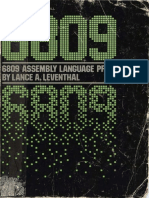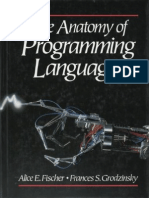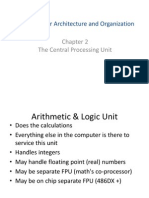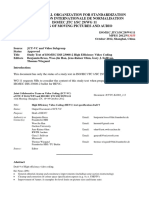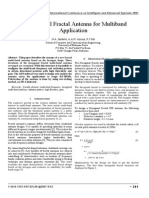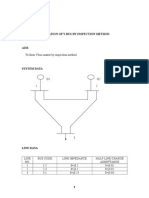50% (6) 50% found this document useful (6 votes) 2K views 383 pages ARM Assembly Language
Copyright
© © All Rights Reserved
We take content rights seriously. If you suspect this is your content,
claim it here .
Available Formats
Download as PDF or read online on Scribd
Go to previous items Go to next items
Save ARM Assembly Language For Later SECOND EDITION
ARM ASSEMBLY |
PANE ele ie
Fundamentals and areal�CRE Press.
‘Taylor & Francis Group
6000 Broken Sound Parkway NW, Suite 300
Boca Raton, FL 33487-2742
© 2015 by William Hohl and Christopher Hinds
CRC Press is an imprint of Taylor & Francis Group, an Informa business
No claim to original U.S. Government works
Printed on acid-free paper
Version Date: 20140915
International Standard Book Number-13:978-1-4822-2985-1 (Hardback)
This book contains information obtained feom authentic and highly regarded sources. Reasonable efforts
have been made to publish reliable data and information, but the author and publisher cannot assume
responsibility for the validity of all materials or the consequences of their use. The authors and publishers
have attempted to trace the copyright holders of all material reproduced in this publication and apologize to
copyright holders if permission to publish in this form has not been obtained. If any copyright material has
not been acknowledged please write and let us know so we may rectify in any future reprint.
Except as permitted under U.S. Copyright Law, no part of this book may be reprinted, reproduced, transmit-
ted, or utilized in any form by any electronic, mechanical, or other means, now known or hereafter invented,
including photocopying, microfilming, and recording, or in any information storage or retrieval system,
without written permission from the publishers.
For permission to photocopy or use material electronically from this work, please access www.copyright.
com (http:/www.copyright.com/) or contact the Copyright Clearance Center, Inc. (CCC), 222 Rosewood
Drive, Danvers, MA 01923, 978-750-8400. CCC is a not-for-profit organization that provides licenses and,
registration for a variety of users. For organizations that have been granted a photocopy license by the CCC,
a separate system of payment has been arranged.
‘Trademark Notice: Product or corporate names may be trademarks or registered trademarks, and are used.
only for identification and explanation without intent to infringe.
Library of Congress Cataloging-in-Publication Data
Hohl, William
ARM assembly language : fundamentals and techniques / William Hohl and
Christopher Hinds. -- Second edition.
pages cm
Includes bibliographical references and index.
ISBN 978-1-4822-2985-1 (hardback)
1, Assembly languages (Electronic computers) 2. Embedded computer
systems--Programming, I. Hinds, Christopher. Il. Title.
(QA76.73.A8H637 2014
006.2°2--de23 2014024230
Visit the Taylor & Francis Web
hetp://www.taylorandfrancis.com
and the CRC Press Web site at
http:/www.crepress.com�Contents
Preface...
Pirate crecessesnrvensnscusnonete
Chapter 1 An Overview of Computing Systems...
1.3
14
15
1.6
17
18
Chapter 2. The Programmer's Model
ppp
bo
2.5
XV
oe XXH
Introduction ..
History of RISC.
1.2.1 ARM Begins...
1.2.2. The Creation of ARM Ltd.
1.2.3 ARM Today
1.2.4 The Cortex Family... ss cae
1.24.1 The Cortex-A and Corte R Families.noun. 10
1.2.4.2 The Cortex-M Family
The Computing Device......
Number Systems...
Representations of Numbers and Character
1.5.1 Integer Representations
1.5.2. Floating-Point Representations
1.5.3 Character Representations..
Translating Bits to Commands...
The Tools.
1.7.1 Open Source Too
1.7.2 Keil (ARM)
1.7.3. Code Composer Studio....
1.7.4 Useful Documentation.
Exercises
Introduction
Data Types...
ARM7TDMI
2.3.1 Processor Modes
2.3.2 Registers...
2.3.3. The Vector Table ..
Cortex-M4. _
2.4.1 Processor Modes...
2.4.2. Registers.
24.3. The Vector Table
Exercises...
vii�viii
Chapter 3
Chapter 4
Introduction to Instruction Sets: v4T and v7-M
3.1
3.2
3.3
Assembler Rules and Directives...
4.1
42
43
44
47
Contents
Introduction ..
ARM, Thumb, and Thumb-2 Instructions
Program 1: Shifting Data..
3.3.1 Running the Code.
3.3.2 Examining Register and Memory Contents..
Program 2: Factorial Calculation
Program 3: Swapping Register Contents,
Program 4: Playing with Floating-Point Number
Program 5: Moving Values between Integer and Floating-
Point Registers...
Programming Guidelines
Exercises....
Introduction ..
Structure of Assembly Language Modules
Predefined Register Names ....
Frequently Used Directives
44.1 Defining a Block of Data or Code
44.1.1 Keil Tools...
2 Code Composer Studio Tool:
4.4.2 Register Name Definition
4.4.2.1 Keil Tools..
4.4.2.2 Code Composer Studio
4.4.3. Equating a Symbol to a Numeric Constant
z 1 Keil Tools...
2 Code Composer Studio
4.4.4 Declaring an Entry Point
4.4.5. Allocating Memory and Specifying Contents
44.5.1 Keil Tools..
44.5.2 Code Composer Studio
4.4.6 Aligning Data or Code to Appropr
4.4.6.1 Keil Tools..
4.4.6.2 Code Composer Studio.
44.7 Reserving a Block of Memory
Keil Tools... i
4.
4.4.8 Assigning Literal Pool Origins
4.4.9 Ending a Source File
Macros...
Miscellaneous Assembler Features
4.6.1 Assembler Operators
4.6.2. Math Functions in CCS
Exercises�Contents
Chapter 5
Chapter 6
Chapter 7
Loads, Stores, and Addressing .
5.1 Introduction
5.2. Memory.
5.3 Loads and Stores: The Instructions.
5.4 Operand Addressing...
5.4.1 Pre-Indexed Addressing .
5.4.2 Post-Indexed Addressing
5.5 Endianness.
5.5.1 Changing Endiannes
5.5.2 Defining Memory Areas
5.6 Bit-Banded Memory...
5.7 Memory Considerations
5.8 Exercises
Constants and Literal Pools.........
6.1 Introduction
6.2 The ARM Rotation Scheme ..
6.3 Loading Constants into Registers.
6.4 Loading Constants with MOVW, MOVT .
6.5 Loading Addresses into Registers
6.6 Exercises... 9s
a 1S
119
Integer Logic and Arithmetic......
7.1 Introduction ...
7.2 Flags and Their Us
7.2.1 The N Flas
7.2.2 The V Flag 121
723 122
724 123
7.3 Comparison Instructions
7.4 Data Processing Operation:
7.4.1 Boolean Operation:
7.4.2 Shifts and Rotates.
7.4.3. Addition/Subtraction
7.4.4 — Saturated Math Operations
7.4.5 Multiplication...
7.4.6 Multiplication by a Constant.
74.7 _ Division...
7.5 DSP Extensions
76 Bit Manipulation Instructions
7.7 Fractional Notation
7.8 Exercises�Chapter 8 Branches and Loops
Chapter 9
Contents
8.1 Introduction
8.2 Branching ..
8.2.1 Branching (ARM7TDMI
8.2.2. Version 7-M Branches.
8.3. Looping...
8.3.1 While Loops
8.3.2 For Loops
8.3.3 Do-While Loops.
8.4 Conditional Execution......
8.4.1 v4T Conditional Execution.
8.4.2. v7-M Conditional Execution:
8.5. Straight-Line Codin;
8.6 Exercises...
Introduction to Floating-Point: Basics, Data Types,
and Data Transfer... .. 175
175
175
9.1 Introduction ..
9.2 A Brief History of Floating-Point in Computing .
9.3 The Contribution of Floating-Point to the Embedded
Processor 178
9.4 Floating-Point Data Types 180
9.5 The Space of Floating-Point Repesenabl Valu .. 183
9.6 Floating-Point Representable Values...
9.6.1 Normal Values...
9.6.2 Subnormal Values
9.6.3 Zeros.
9.6.4 Infinitie:
9.6.5 Not-a-Numbers (NaNs)
9.7 The Floating-Point Register File of the Cortex-M4. 192
9.8 — FPU Control Registers... 193
9.8.1 The Floating-Point Status and Control
Register, FPSCR... 193
9.8.1.1 The Control and Mode Bit 194
The Exception Bi 195
9.8.2 The Coprocessor Access Control Register,
CPACR
9.9 Loading Data into Floating-Point Registers
9.9.1 Floating-Point Loads and Stores: The
Instructions...
9.9.2| The VMOV instruction 6
9.10 Conversions between Half-Precision and Single-Pre
9.11 Conversions to Non-Floating-Point Formats.
9.11.1 Conversions between Integer and Floating-Point.�Contents xi
9.11.2. Conversions between Fixed-Point and
Floating-Point
9.12 Exercises.
Chapter 10 Introduction to Floating-Point: Rounding and Exceptions......
10.1 Introduction
10.2. Rounding ..
10.2.1 Introduction to Rounding Modes in the IEEE
754-2008 Specification...
10.2.2. The roundTiesToEven (RNE) Rounding Mode.
10.2.3 The Directed Rounding Modes a
10.2.3.1 The roundTowardPositive (RP)
Rounding Mod.
10.2.3.2. The roundTowardNegative (RM)
Rounding Mode....... .
10.2.3.3 The roundTowardZero (RZ) Rounding
Mode. . i
10.2.4 Rounding Mode Summary
10.3 Exceptions...
10.3.1 Introduction to Floating-Point Exception
10.3.2. Exception Handling.. .
10.3.3 Division by Zero
10.3.4 Invalid Operation
10.3.5. Overflow...
10.3.6 Underflow
10.3.7 Inexact Result...
10.4 Algebraic Laws and Floating-Point.
10.5 Normalization and Cancelation...
10.6 Exercises
Chapter 11 Floating-Point Data-Processing Instructions
11.1 Introduction .. so
11.2. Floating-Point Data-Processing Instruction Syntax
11.3. Instruction Summar}
11.4 Flags and Their Use.......
11.4.1 Comparison Instructions
11.4.2 The N Fla;
11.4.3
11.4.4
11.4.5
11.4.6 Predicated Instructions, or the Use of the Flags
11.4.7 A Word about the IT Instruction
11.5. Two Special Mode:
11.5.1 Flush-to-Zero Mode�Chapter 12 Tables.
Chapter 13 Subroutines and Stacks...
Chapter 14 Exception Handling: ARM7TDMI.....
Contents
11.5.2 Default NaN
11.6 Non-Arithmetic Instructions
11.6.1 Absolute Value ....
11.6.2. Negat
11.7. Arithmetic Instructions
11.7.1 Addition/Subtraction
11.7.2. Multiplication and Multiply—Accumulate
11.7.2.1 Multiplication and Negate
Multiplication.
1.7.2.2. Chained Multiply. Acoust
11.7.2.3. Fused Multiply-Accumulate....
11.7.3. Division and Square Root.
11.8 Putting It All Together: A Coding Exampl
11.9. Exercises.
12.1 Introduction ..
12.2. Integer Lookup Tables...
12.3. Floating-Point Lookup Table:
12.4 Binary Searches
12.5 Exercises.......
13.1 Introduction ...
13.2 The Stack...
13.2.1 LDM/STM Instruction:
13.2.2. PUSH and POP.
13.2.3 Full/Empty Ascending/Des
13.3. Subroutines...
13.4 Passing Parameters to Subroutines........
13.4.1 Passing Parameters in Registers
13.4.2. Passing Parameters by Reference:
13.4.3 Passing Parameters on the Stack
13.5) The ARM APCS esses
13.6 Exercises...
14.1 Introduction
14.2 Interrupts
14.3 Error Conditions...
14.4. Processor Exception Sequence.
14.5 The Vector Table.
14.6 Exception Handler�Contents xiii
14.7 Exception Prioritie
14.8 Procedures for Handling Exception:
14.8.1 Reset Exceptions ..
14.8.2. Undefined Instructions
14.8.3. Interrupts...
14.8.3.1 Vectored Interrupt Controtle
14.8.3.2. More Advanced VICs
14.8.4 Aborts..
14.8.4.1 Prefetch Aborts
14.8.4.2 Data Aborts...
5 SVC
14.9 Exercises...
Chapter 15. Exception Handling: v7-M.....
Introduction .. .
Operation Modes and Privilege Levels
The Vector Table .. ;
Stack Pointers .
Processor Brenton Sequence.
15.5.1 Entry.
Exception Types ..
Chapter 16 Memory-Mapped Peripherals...
16.1 Introduction ...
The Memory Map
Configuring the UART....
Writing the Data to the UART
Putting the Code Togethel
Running the Code.
‘The Memory Map
Configuring the D/A Converter.
Generating a Sine Wave ..
Putting the Code Togethe
Running the Code.
16.4 The Tiva Launchpad...
16.4.1 General-Purpose /O
16.4.2. The Memory Map�Chapter 17
Chapter 18
Contents
16.4.3 Configuring the GPIO Pins
16.4.4 Turning on the LEDs....
16.4.5. Putting the Code Togethe
16.4.6 Running the Code
16.5. Exercises...
ARM, Thumb and Thumb-2 Instructions...........
17.1 Introduction... —
17.2. ARM and 16-Bit Thumb Instructions "
17.2.1 Differences between ARM and 16-Bit Thumb
17.2.2. Thumb Implementation.
17.3. 32-Bit Thumb Instructions ..
17.4 Switching between ARM sand Thumb Seates.
17.5 How to Compile for Thumb .. .
17.6 Exercises...
Mixing C and Assembly.
18.1 Introduction
18.2 Inline Assembler...
18.2.1 Inline Assembly Syntax. :
18.2.2. Restrictions on Inline Assembly Operations...
18.3. Embedded Assembler.
18.3.1 Embedded Assembly Syntax...
18.3.2 Restrictions on Embedded Assembly Operations. 387
18.4 Calling between C and Assembly ...
18.5 Exercises
Appendix A: Running Code Composer Studi 393
Appendix B: Running Keil To0}s..........0.00:0nesnsnennnnnninnennannnnnse 399
Appendix C: ASCII Character Codes .... 407
‘Appendix D.... 409
Glossary ..
References.
Index,�a
You have either reached 2 page thts unevalale fer vowing or reached your ievina tit for his
book.�a
You have either reached 2 page thts unevalale fer vowing or reached your ievina tit for his
book.�a
You have either reached 2 page thts unevalale fer vowing or reached your ievina tit for his
book.�a
You have either reached 2 page thts unevalale fer vowing or reached your ievina tit for his
book.�a
You have either reached 2 page thts unevalale fer vowing or reached your ievina tit for his
book.�a
You have either reached 2 page thts unevalale fer vowing or reached your ievina tit for his
book.�Authors
William Hohl held the position of Worldwide University Relations Manager for
ARM, based in Austin, Texas, for 10 years, He was with ARM for nearly 15 years
and began as a principal design engineer to help build the ARM1020 microproces-
sor. His travel and university lectures have taken him to over 40 countries on 5
continents, and he continues to lecture on low-power microcontrollers and assembly
language programming. In addition to his engineering duties, he also held an adjunct
faculty position in Austin from 1998 to 2004, teaching undergraduate mathematics.
Before joining ARM, he worked at Motorola (now Freescale Semiconductor) in the
ColdFire and 68040 design groups and at Texas Instruments as an applications engi-
neer. He holds MSEE and BSEE degrees from Texas A&M University as well as six
patents in the field of debug architectures.
Christopher Hinds has worked in the microprocessor design field for over 25 years,
holding design positions at Motorola (now Freescale Semiconductor), AMD, and
ARM. While at ARM he was the primary author of the ARM VEP floating-point
architecture and led the design of the ARM10 VFP, the first hardware implementa-
tion of the new architecture, Most recently he has joined the Patents Group in ARM,
identifying patentable inventions within the company and assisting in patent litiga~
tion. Hinds is a named inventor on over 30 US patents in the areas of floating-point
implementation, instruction set design, and circuit design. He holds BSEE and MSEE
degrees from Texas A&M University and an MDiv from Oral Roberts University,
where he worked to establish the School of Engineering, creating and teaching the
first digital logic and microprocessor courses. He has numerous published papers
and presentations on the floating-point architecture of ARM processors.
xxi�a
You have either reached 2 page thts unevalale fer vowing or reached your ievina tit for his
book.�a
You have either reached 2 page thts unevalale fer vowing or reached your ievina tit for his
book.�a
You have either reached 2 page thts unevalale fer vowing or reached your ievina tit for his
book.�a
You have either reached 2 page thts unevalale fer vowing or reached your ievina tit for his
book.�a
You have either reached 2 page thts unevalale fer vowing or reached your ievina tit for his
book.�a
You have either reached 2 page thts unevalale fer vowing or reached your ievina tit for his
book.�a
You have either reached 2 page thts unevalale fer vowing or reached your ievina tit for his
book.�An Overview of Computing Systems 7
1.2.2 THe Creation or ARM Lr.
In 1989, the dominant desktop architectures, the 68000 family from Motorola and
the x86 family from Intel, were beginning to integrate memory management units,
caches, and floating-point units on board the processor, and clock rates were going
up—25 MHz in the case of the first 68040. (This is somewhat misleading, as this
processor used quadrature clocks, meaning clocks that are derived from overlapping
phases of two skewed clocks, so internally it was running at twice that frequency.) To
compete in this space, the ARM3 was developed, complete with a 4K unified cache,
also running at 25 MHz. By this point, Acorn was struggling with the dominance of
the IBM PC in the market, but continued to find sales in education, specialist, and
hobbyist markets. VLSI Technology, however, managed to find other companies will-
ing to use the ARM processor in their designs, especially as an embedded processor,
and just coincidentally, a company known mostly for its personal computers, Apple.
was looking to enter the completely new field of personal digital assistants (PDAS).
Apple’s interest in a processor for its new device led to the creation of an entirely
separate company to develop it, with Apple and Acorn Group each holding a stake,
and Robin Saxby (now Sir Robin Saxby) being appointed as managing director. The
new company, consisting of money from Apple, twelve Acorn engineers, and free
tools from VLSI Technology, moved into a new building, changed the name of the
architecture from Acorn RISC Machine to Advanced RISC Machine, and developed
a completely new business model. Rather than selling the processors, Advanced
RISC Machines Ltd. would sell the rights to manufacture its processors to other
companies, and in 1990, VLSI Technology would become the first licensee. Work
began in earnest to produce a design that could act as either a standalone processor
or a macrocell for larger designs, where the licensees could then add their own logic
to the processor core. After making architectural extensions, the numbering skipped
a few beats and moved on to the ARM6 (this was more of a marketing decision than
anything else). Like its competition, this processor now included 32-bit addressing
and supported both big- and little-endian memory formats. The CPU used by Apple
was called the ARM610, complete with the ARM6 core, a 4K cache, a write buf-
fer, and an MMU. Ironically, the Apple PDA (known as the Newton) was slightly
ahead of its time and did quite poorly in the market, partly because of its price and
partly because of its size. It wouldn't be until the late 1990s that Apple would design
a device based on an ARM7 processor that would fundamentally change the way
people viewed digital media—the iPod.
The ARM7 processor is where this book begins. Introduced in 1993, the design
was used by Acorn for a new line of computers and by Psion for a new line of PDAs,
but it still lacked some of the features that would prove to be huge selling points for
its successor—the ARM7TDMI, shown in Figure 1.4. While it’s difficult to imag-
ine building a system today without the ability to examine the processor’s registers
the memory system, your C++ source code, and the state of the processor all in a
nice graphical interface, historically, debugging a part was often very difficult and
involved adding large amounts of extra hardware to a system. The ARM7TDMI
expanded the original ARM7 design to include new hardware specifically for an
external debugger (the initials “D” and “I” stood for Debug and ICE, or In-Circuit�a
You have either reached 2 page thts unevalale fer vowing or reached your ievina tit for his
book.�a
You have either reached 2 page thts unevalale fer vowing or reached your ievina tit for his
book.�a
You have either reached 2 page thts unevalale fer vowing or reached your ievina tit for his
book.�An Overview of Computing Systems "
to support large operating systems, such as Linux, Android, and Windows. At the
high end of the computing spectrum, these processors are also likely to support sy
tems containing multiple cores, such as those found in servers and wireless base st
tions, where you may need up to eight processors at once. The 32-bit Cortex-A family
includes the Cortex-A5, A7, A8, A9, Al2, and A15 cores. Newer, 64-bit architectures
include the A57 and A53 processors. In many designs, equipment manufacturers build
custom solutions and do not use off-the-shelf SoCs; however, there are quite a few
commereial parts from the various silicon vendors, such as Freescale’s i.MX line based
around the Cortex-A8 and A9; TI’s Davinci and Sitara lines based on the ARM9 and
Cortex-A8; Atmel’s SAMASD3 products based on the Cortex-A5; and the OMAP and
Keystone multi-core solutions from TI based on the Cortex-A15. Most importantly,
there are very inexpensive evaluation modules for which students and instructors can
write and test code, such as the Beaglebone Black board, which uses the Cortex-A8.
The Cortex-R cores (R4, R5, and R7) are designed for those applications where
real-time and/or safety constraints play a major role; for example, imagine an embed-
ded processor designed within an anti-lock brake system for automotive use. When
the driver presses on the brake pedal, the system is expected to have completely
deterministic behavior—there should be no guessing as to how many cycles it might
take for the processor to acknowledge the fact that the brake pedal has been pressed!
In complex systems, a simple operation like loading multiple registers can introduce
unpredictable delays if the caches are turned on and an interrupt comes in at the just
the wrong time. Safety also plays a role when considering what might happen if a
fails or becomes corrupted in some way, and the solution involves build-
ing redundant systems with more than one processor. X-ray machines, CT scan-
ners, pacemakers, and other medical devices might have similar requirements. These
cores are also likely to be asked to work with operating systems, large memory
systems, and a wide variety of peripherals and interfaces, such as Bluetooth, USB,
and Ethernet. Oddly enough, there are only a handful of commercial offerings right
now, along with their evaluation platforms, such as TMS570 and RM4 lines from TI.
1.2.4.2, The Cortex-M Family
Finally, the Cortex-M line is targeted specifically at the world of microcontrollers,
parts which are so deeply embedded in systems that they often go unnoticed. Within
this family are the Cortex-M0, M0+, MI, M3, and M4 cores, which the silicon ven-
dors then take and use to build their own brand of off-the-shelf controllers. As the
much older, 8-bit microcontroller space moves into 32-bit processing, for controlling
car seats, displays, power monitoring, remote sensors, and industrial robotics, indus-
try requires a variety of microcontrollers that cost very little, use virtually no power,
and can be programmed quickly. The Cortex-M family has surfaced as a very popu-
lar product with silicon vendors: in 2013, 170 licenses were held by 130 companies,
with their parts costing anywhere from two dollars to twenty cents. The Cortex-M0
is the simplest, containing only a core, a nested vectored interrupt controller (NVIC),
a bus interface, and basic debug logic. Its tiny size, ultra-low gate count, and small
instruction set (only 56 instructions) make it well suited for applications that only
require a basic controller. Commercial parts include the LPC1100 line from NXP,
and the XMC1000 line from Infineon. The Cortex-M0+ is similar to the MO, with�a
You have either reached 2 page thts unevalale fer vowing or reached your ievina tit for his
book.�a
You have either reached 2 page thts unevalale fer vowing or reached your ievina tit for his
book.�a
You have either reached 2 page thts unevalale fer vowing or reached your ievina tit for his
book.�An Overview of Computing Systems 15
1.4. NUMBER SYSTEMS
Since computers operate internally with transistors acting as switches, the combi-
national logic used to build adders, multipliers, dividers, ete., understands values
of I or 0, either on or off. The binary number system, therefore, lends itself to use
in computer systems more easily than base ten numbers. Numbers in base two are
centered on the idea that each digit now represents a power of two, instead of a
power of ten. In base ten, allowable numbers are 0 through 9, so if you were to count
the number of sheep in a pasture, you would say 0, 1, 2, 3, 4, 5, 6, 7, 8, 9, and then
run out of digits. Therefore, you place a | in the 10’s position (see Figure 1.10), to
indicate you've counted this high already, and begin using the old digits again—10,
Il, 12, 13, ete.
Now imagine that you only have two digits with which to count: 0 or 1. To count
that same set of sheep, you would say 0, 1 and then you're out of digits. We know the
next value is 2 in base ten, but in base two, we place a | in the 2’s position and keep
counting—10, I, and again we're out of digits to use. A marker is then placed in the
4's position, and we do this as much as we like.
EXAMPLE 1.1
Convert the binary number 110101, to decimal.
SowTiON
This can be seen as
This would be equivalent to 32 + 16 +4 +1=53,q.
The subscripts are normally only used when the base is not 10. You will see
quickly that a number such as 101 normally doesn’t raise any questions until you
start using computers. At first glance, this is interpreted as a base ten number—
one hundred one. However, careless notation could have us looking at this num-
ber in base two, so be careful when writing and using numbers in different bases.
After staring at I's and 0’s all day, programming would probably have people jump-
ing out of windows, so better choices for representing numbers are base eight (octal,
although you'd be hard pressed to find a machine today that mainly uses octal nota~
tion) and base sixteen (hexadecimal or hex, the preferred choice), and here the digits
10? 10! 109
43 8
7 AN
Ahundreds | 8 ones
Btens
FIGURE 1.10 Base ten representation of 438.�a
You have either reached 2 page thts unevalale fer vowing or reached your ievina tit for his
book.�a
You have either reached 2 page thts unevalale fer vowing or reached your ievina tit for his
book.�a
You have either reached 2 page thts unevalale fer vowing or reached your ievina tit for his
book.�An Overview of Computing Systems 19
One’s complement numbers are not used much in modern computing systems
either, mostly because there is too much extra work necessary to perform basic
arithmetic operations. To create @ negative value in this representation, simply
invert all the bits of its positive, binary value. The sign bit will be a 1, just like
sign-magnitude representations, but there are two issues that arise when work-
ing with these numbers. The first is that you end up with two representations for
0, and the second is that it may be necessary to adjust a sum when adding two
values together, causing extra work for the processor. Consider the following two
examples.
EXAMPLE 1.6
Assuming that you have 16 bits to represent a number, add the values ~124 to 236
in one’s complement notation.
SowTION
To create ~124 in one’s complement, simply write out the binary representation
for 124, and then invert all the bits:
124 — 0000000001111100
-124-1111111110000011
Adding 236 gives us
-124 1111111110000011
+236 +0000000011101100
carry > 1 0000000001101111
The problem is that the answer is actually 112, or 0x70 in hex. In one’s comple-
ment notation, a carry in the most significant bit forces us to add a one back into
the sum, which is one extra step
0000000001101111
+1 og 1
112 0000000001110000
EXAMPLE 1.7
Add the values ~8 and 8 together in one’s complement, assuming 8 bits are avail-
able to represent the numbers,
SowuTiON
Again, simply take the binary representation of the positive value and invert all
the bits to get -8:



